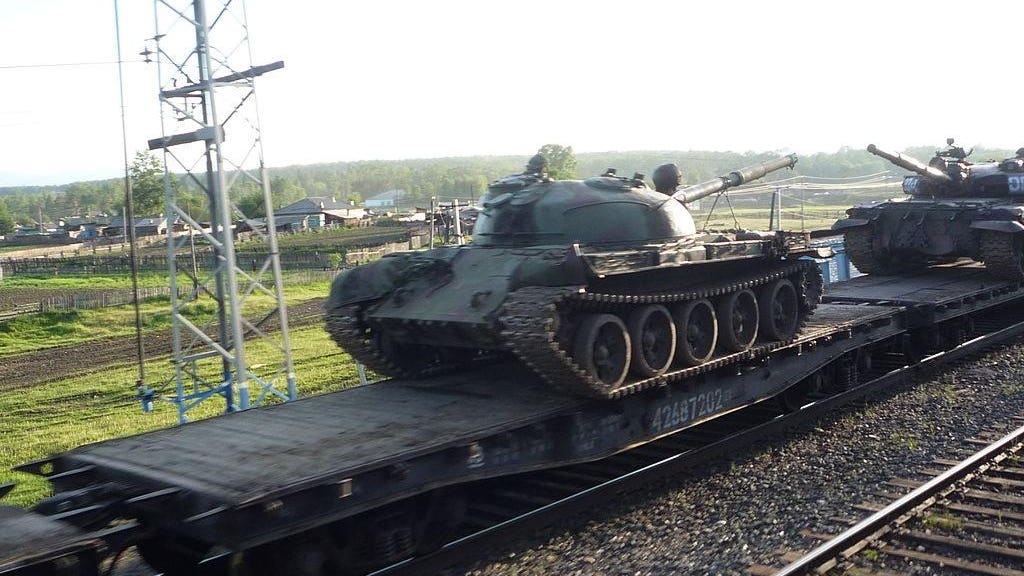It’s apparent that, in the months and weeks leading up to the Ukrainian armed forces’ 2023 counteroffensive, which kicked off in early June, planners in Kyiv agreed on at least one main objective.
That objective: to advance forces far enough south from Mala Tokmachka, in southern Ukraine’s Zaporizhzhia Oblast, toward Russian-occupied Melitopol—50 miles to the south—in order to bring the town of Tokmak under Ukrainian fire-control.
In recent days, Ukrainian brigades finally met the objective. Sometime in the first week of October, Ukrainian artillery—perhaps American-made High-Mobility Artillery Rocket System launchers—edged close enough to Tokmak to hit a Russian supply train rolling near the town.
A dramatic video that circulated online on Sunday depicts the train in flames.
The implication is an important one. Russian logistics in occupied southern Ukraine now are in serious trouble. Tokmak is a major road and rail hub: arguably the most important hub in southwestern Ukraine.
Unravel the overland supply lines threading through Tokmak, and you unravel the garrisons that depend on those supply lines for food, fuel, ammunition and replacement troops and vehicles.
All that is to say, bringing Tokmak into artillery and rocket range is a major step toward the Ukrainians’ ultimate goal of defeating the Russian field armies in the south, and liberating the thousands of square miles they occupy. Including Crimea, the strategic peninsula that Russia forcibly annexed in 2014.
This isn’t the end of Russia’s 21-month wider war on Ukraine. It isn’t even the beginning of the end. But it’s a development that signals some of Kyiv’s major war aims, and also illuminates the preparations Moscow is making to prolong the war—and to maintain its hold on occupied territory.
At the same time the Ukrainians are targeting the supply lines passing through Tokmak, the Russians are hard at work establishing new supply lines, farther south. If the Russians succeed in diverting trucks and trains away from Tokmak, they partially could defeat the Ukrainians’ counterattacks along the Melitopol axis—by rendering the counterattacks strategically meaningless.
The Ukrainian strike on that Russian train near Tokmak only recently was possible. While Ukrainian forces possess an array of deep-strike weapons—Storm Shadow and SCALP land-attack missiles, Neptune and Harpoon anti-ship missiles, S-200 and Tochka ballistic missiles and several types of drones—these weapons generally work best against static targets.
Hitting a moving train is hard. Which is why Russian efforts to strike Ukraine’s own vital rail network so far have failed to impede Ukrainian logistics.
To strike that ammo train, the Ukrainians needed good, fresh intelligence, possibly from drones or local partisans. But they also needed to bring to bear their most responsive and most accurate fires. That is, their GPS-guided Excalibur artillery shells and Guided Multiple Launch Rockets.
The Excaliburs fire from American-made M777 howitzers out to a range of around 19 miles. GLMRS fires from HIMARS launchers out to a distance of 44 miles.
The Ukrainians keep their M777s a few miles from the front line in order to complicate Russian counterbattery fire; they keep their precious HIMARS even farther back. The line of contact probably needed to stabilize somewhere around Robotyne, 12 miles north of Tokmak, before Ukraine’s precision artillery effectively could target trains rolling through Tokmak.
A powerful force of Ukrainian brigades, including the best-equipped 47th Mechanized and 82nd Air Assault Brigades, fought their way to Robotyne this summer—at incredible cost—and finally liberated the settlement in August. The artillery soon followed, and the counterlogistics campaign targeting Tokmak began in earnest.
Expect many more precision strikes on Russian trains and convoys in and around Tokmak in the coming weeks and months as Ukraine aims to extend its summer counteroffensive into the fall and winter. Also expect the Russians to adapt—or at least try to adapt.
The apparent construction, by Russian engineers, of a new railway through occupied Mariupol, on the Black Sea coast a hundred miles east of Melitopol, could shift Russia’s overland supply lines through southern Ukraine away from Tokmak—and closer to the coast.
If the Russians succeed in adapting their logistical system, and fast, they could compel the Ukrainians also to adapt—by establishing a new goal for their counteroffensive. If the Russians move their supply lines farther south, the Ukrainians might have to advance farther south in order reliably to strike these same supply lines.
That would be an ominous development for Kyiv. It cost the Ukrainians hundreds of vehicles and potentially thousands of lives to bring Tokmak under fire-control. It could cost them much more than that to bring the Black Sea coast under fire-control.
Read the full article here





